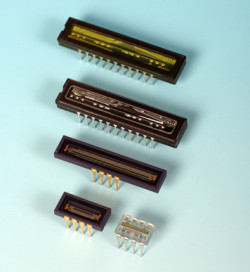Detector Arrays

The AvaSpec spectrometers can be equipped with several types of detector arrays. Presently we offer silicon-based CCD, back-thinned CCD, CMOS and Photo Diode Arrays for the 200-1100 nm range. A complete overview is given in the next section " Sensitivity " in table 4. For the NIR range (1000-2500nm) InGaAs arrays are implemented.
CCD Detectors (AvaSpec-2048/3648)
The Charged Coupled Device (CCD) detector stores the charge, dissipated as photons strike the photoactive surface. At the end of a controlled time-interval (integration time), the remaining charge is transferred to a buffer and then this signal is being transferred to the AD converter. CCD detectors are naturally integrating and therefore have enormous dynamic range, only limited by the dark (thermal) current and the speed of the AD converter. The 3648 pixel CCD has an integrated electronic shutter function, so an integration time of 10µsec can be achieved.
+ Advantages for the CCD detector are many pixels (2048 or 3648), high sensitivity and high speed.
- Main disadvantage is the lower S/N ratio.
UV enhancement
For applications below 350 nm with the AvaSpec-2048/3648 a special DUV-detector coating is required. The uncoated CCD-response below 350 nm is very poor; the DUV lumogen coating enhances the detector response in the region 150-350nm. The DUV coating has a very fast decay time, typ. in ns range and is therefore useful for fast trigger LIBS applications.
Back-thinned CCD Detectors (AvaSpec-2048x14)
For applications requiring high quantum efficiency in the UV (200-350nm) and NIR (900-1160nm) range, combined with good S/N and a wide dynamic range, the new back-thinned CCD detector may be the right choice. The detector is an area detector of 2048x14 pixels, for which the vertical 14 pixels are binned (electronically added together) to have more sensitivity and a better S/N performance.
+ Advantage of the back-thinned CCD detector is the good UV and NIR sensitivity, combined with good S/N and dynamic range
- Disadvantage is the relative high cost
Photo Diode Arrays (AvaSpec-128)
A silicon photodiode array consists of a linear array of multiple photo diode elements, for the AvaSpec-128 this is 128 pixels. Each pixel consists of a P/N junction with a positively doped P region and a negatively doped N region. When light enters the photodiode, electrons will become excited and output an electrical signal. Most photodiode arrays have an integrated signal processing circuit with readout/integration amplifier on the same chip.
+ Advantages for the Photodiode detector are high NIR sensitivity and high speed.
- Disadvantages are limited amount of pixels and no UV response.
CMOS linear image sensors (AvaSpec-256/1024)
These so called CMOS linear image sensors have a lower charge to voltage conversion efficiency than CCD array sensors and are therefore less light sensitive, but have a much better signal to noise ratio.
The CMOS detectors have a higher conversion gain than NMOS detectors and also have a clamp circuit added to the internal readout circuit to suppress noise to a low level.
+ Advantages for the CMOS detectors are good S/N ratio and good UV sensitivity.
- Disadvantages are the low readout speed en relative high cost (1024 pixels).
InGaAs linear image sensors (AvaSpec-NIR256)
The InGaAs linear image sensors deliver high sensitivity in the NIR wavelength range. The detector consists of a charge amplifier array with CMOS transistors, a shift register and timing generator. 3 versions of detectors are available:
- 256 pixel non-cooled InGaAs detector for the 900-1750nm range
- 256 pixel 2-stage cooled Extended InGaAs detector for the 1000-2200nm range
- 256 pixel 2-stage cooled Extended InGaAs detector for the 1000-2500nm range
|